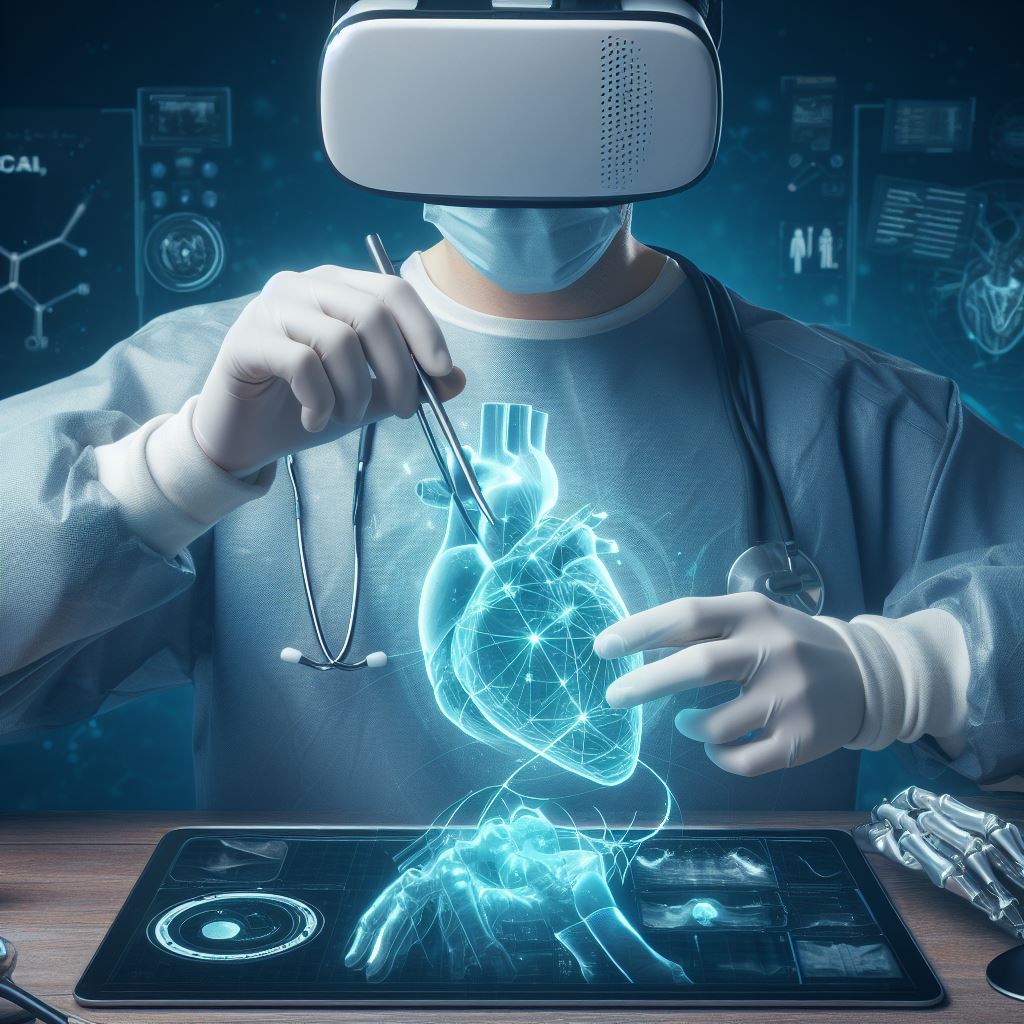Virtual and augmented reality (VR/AR,), is fast changing the healthcare sector by improving patient care and tackling important issues. These technologies have a wide range of uses, from enhancing surgical techniques and medical education to supporting patient recovery and minimizing in-person visits.
Virtual and Augmented Reality in the Healthcare Industry
VR/AR in healthcare is expected to play a major role in the future of healthcare, as the market for this technology is expanding rapidly. Better patient outcomes, more accessibility to healthcare services, more patient satisfaction, better medical education, and support for medical research through artificial intelligence and machine learning are just a few advantages. These technologies have huge promise in the healthcare industry, offering more advancements in patient care and medical practice.
Global Healthcare VR/AR market
The market for augmented reality and virtual reality in healthcare was estimated to be worth USD 2.5 billion in 2022, and it is projected to increase at a CAGR of 18.8% between 2023 and 2030, according to some reports. Augmented reality (AR) and virtual reality (VR) technologies are expected to grow and be adopted in the healthcare industry due to a number of fundamental factors, including medical training, growing usage in surgical procedures, favorable government initiatives, rising healthcare expenditures, and technological advancements and digitalization in healthcare. There are several uses for these technologies in the medical field, including surgery, diagnosis, rehabilitation, teaching, and training.
Challenges in Medical Care System
Big obstacles including access restrictions, equipment availability, personnel shortages, and logistical difficulties are common in the healthcare industry. A viable approach to resolving these problems, meanwhile, is the combination of Virtual Reality (VR) and Augmented Reality (AR) technologies. Innovative answers to these ongoing healthcare problems are provided by these state-of-the-art technologies, which also enable hands-on training, promote immersive experiences, and give access to cutting-edge medical equipment. Because VR provides a safe setting for practical skill development, it is especially important in revolutionizing medical education. It includes a variety of situations, including emergency case studies, medical equipment usage instruction, and simulations for medical training. VR and AR have a lot of potential for the healthcare industry, and they might lead to better medical education and more efficient healthcare delivery in the future.
Some Use Cases of AR/VR in Medical Care:
The combination of virtual reality (VR) and augmented reality (AR) technology has created a revolutionary wave of innovation in the quickly changing healthcare industry. AR and VR are gaining traction in a number of exciting application cases that are transforming healthcare delivery and revolutionizing medical treatment.
VR Solutions for Surgeons:
Virtual reality (VR) technologies provide surgeons with a useful platform for improving their abilities. These technologies include virtual reality software that lets surgeons practice safe mock procedures in a controlled setting, which promotes skill development. Haptic controls further enhance the experience by assisting users in virtual operations, providing tactile feedback, and improving surgical proficiency. This creative method helps surgeons enhance both their technical proficiency and patient comprehension, which eventually results in more accurate and efficient surgical treatments.
VR in Medical Education:
Virtual reality (VR) technology has completely changed the medical education landscape by giving students access to immersive learning environments. It gives users the chance to interact with AI-controlled virtual patients and interact in great detail with 3D medical models, imitating real-world medical events. This results in a more comprehensive and successful approach to medical education by improving their medical social skills in addition to their mastery of anatomy. Virtual reality (VR) has developed into a vital tool for streamlining the educational process and providing students with an engaging and dynamic environment to hone their medical knowledge and self-assurance.
VR for Physical Therapy:
Virtual reality technology is essential to orthopaedics and injury rehabilitation because it increases patient access, especially for those with mobility problems. Patients can have very effective and entertaining rehabilitation excursions using VR systems. These systems provide patients with training modules that help them regain their mobility and independence by demonstrating to them how to utilise assistive equipment properly. Additionally, AI-powered monitoring guarantees that patients receive constant, individualised care, streamlining the healing process and customising it to meet their individual requirements. Virtual reality (VR) has become a game-changing tool in the field of healthcare, supporting people’s freedom and well-being as they progress towards recovery.
AR Solution for Surgery Assistance:
Augmented reality (AR) has accelerated the development of robotic-assisted surgery by increasing safety and precision during medical procedures. A surgeon can see essential information and instant instruction by having critical patient data overlaid directly into their field of view through the use of augmented reality (AR) technology. Through enhanced decision-making abilities, this integration facilitates surgeons in performing safer and more precise procedures. Furthermore, by extending its benefits to surgical planning, AR contributes to the development of more effective procedural approaches. Through improving physician performance and raising the bar for patient care overall, augmented reality (AR) is proving its disruptive potential in the medical sector.
VR for Rehabilitation:
Virtual reality (VR) technology is transforming the field of rehabilitation and making it more active and interesting for patients. Patients are now more committed to the rehabilitation process because they can measure their progress, set objectives, and get rewards—all of which are aspects of gamification. The addition of AI teachers, who provide patients with highly customised and adaptable rehabilitation programmes catered to their individual requirements, strengthens this strategy even further. Virtual reality (VR) has the potential to change the way patients approach their recovery by making it an interactive, goal-oriented, and personally designed trip that will eventually provide more effective and satisfying results.
Future of AR/VR Technology in Healthcare:
AR and VR technology in healthcare has a bright future ahead of it, with a plethora of uses that might completely change the sector. The possibilities are endless, ranging from helping to operate robotic gadgets to developing immersive therapy programmes. By using augmented reality overlays, surgeons may obtain vital patient data instantly, improving surgery accuracy and safety. Regarding rehabilitation, virtual reality (VR) makes physical treatment fun and game-like, inspiring patients with objectives and successes. The use of AR and VR in healthcare is poised to transform patient care and medical treatment via ongoing improvements, offering a more effective and patient-centered healthcare environment.
Advantages of AR/VR for the Healthcare Industry
Numerous advantages result from the use of AR and VR technology in the healthcare industry, which redefines patient care and medical practise. Immersion simulations are a terrific way to improve medical education since they let professionals practise difficult operations in a safe virtual setting. Because medical personnel are more knowledgeable and experienced, patients receive better results as a consequence. Additionally, patients now have additional options for receiving remote treatment and consultations thanks to AR/VR technology, which is particularly helpful in impoverished areas. These technologies improve patient satisfaction by lowering tension and anxiety, which enhances the whole patient experience.
AI and ML may be used to leverage the massive amounts of data produced by AR and VR systems for medical research. Large datasets may be analysed thanks to these technologies, which can result in novel discoveries, individualised treatment regimens, and advancements in diagnosis. In conclusion, AR and VR have the potential to revolutionise healthcare by fostering efficiency and creativity, raising the bar for medical research and enhancing patient outcomes, treatment quality, and overall experience.
Are you intrigued by the limitless possibilities that modern technologies offer? Do you see the potential to revolutionize your business through innovative solutions? If so, we invite you to join us on a journey of exploration and transformation!
Let’s collaborate on transformation. Reach out to us at open-innovator@quotients.com now!






